This post may contain affiliate links. Please read our disclosure policy.
This delicious homemade sunflower seed butter recipe is made using only ONE ingredient and is gluten-free, sugar-free, nut-free, dairy-free, low FODMAP, Paleo, Keto, and more! This post also contains sunbutter flavor options, and tons of recommended uses!
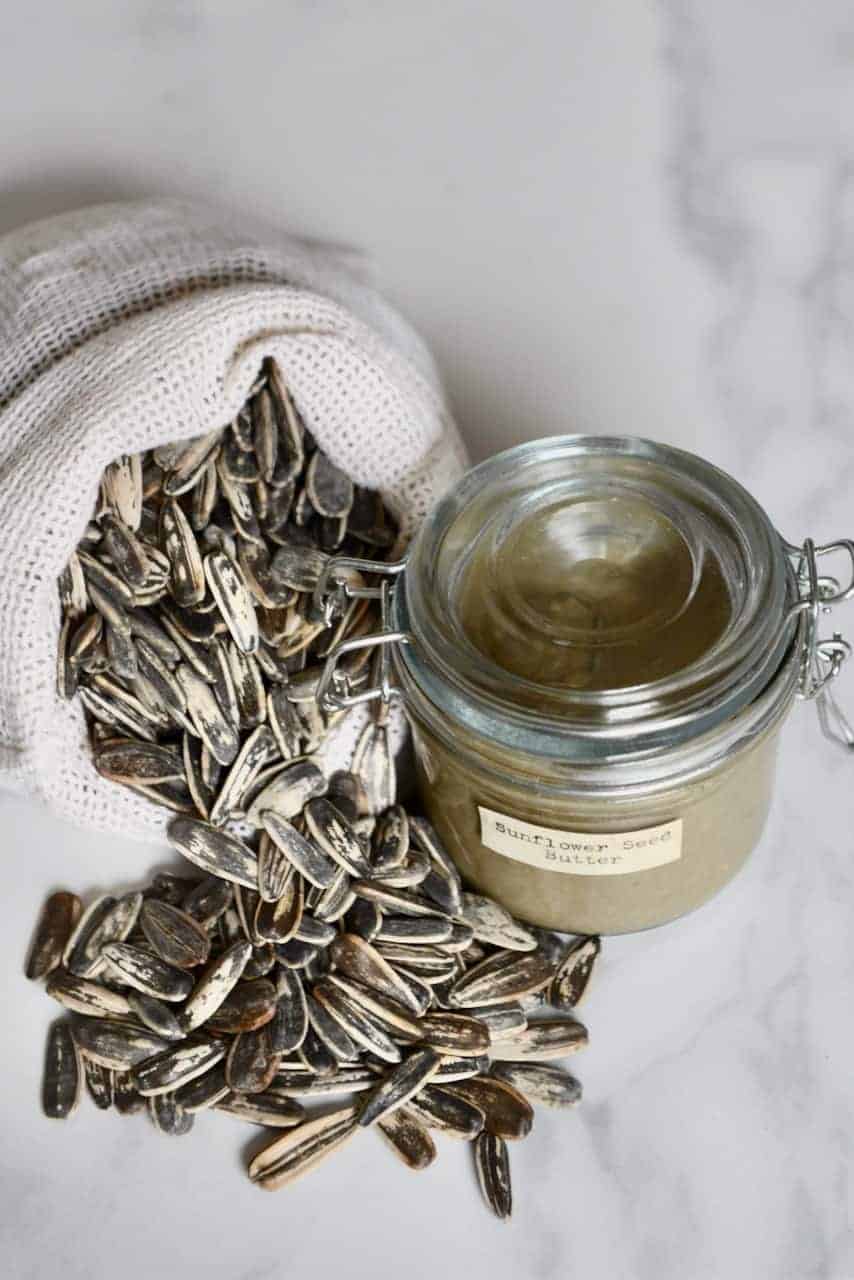
This homemade sunflower seed butter recipe (otherwise known as sunbutter or sunflower butter) is a very frugal seed butter (up there with pumpkin seed butter and homemade tahini – aka sesame seed “butter”). It also works amazingly as an alternative to many types of nut butter in recipes, without giving up on nutrition. Plus you can prepare homemade sunflower butter from raw, soaked (sprouted), or roasted seeds with very little hands-on time!
Sunflower seeds will always have a fond spot in my memory because I remember eating them, roasted and salted, from the shell as a child – a small pile of discarded sunflower seed shells forming beside me. I honestly feel like the sunflower seed in the shell “snack” isn’t something we appreciate enough in the UK!
Want to save this recipe?
Creamy allergy-friendly smooth seed butter
Now, though, we’re focusing on turning this little seed into a smooth and creamy “sun butter” recipe. This sunflower seed butter recipe uses just ONE ingredient – sunflower seeds! Because that is honestly all you need, though with a couple of caveats.
When toasting the seeds, the oils will naturally release in the process, which helps to yield a super-smooth butter. In comparison, when using raw seeds, your machine will have to work a lot harder to extract oils. So, sometimes a tablespoon of extra oil is necessary (for your sanity!) – but not always (keep reading for my top tips!
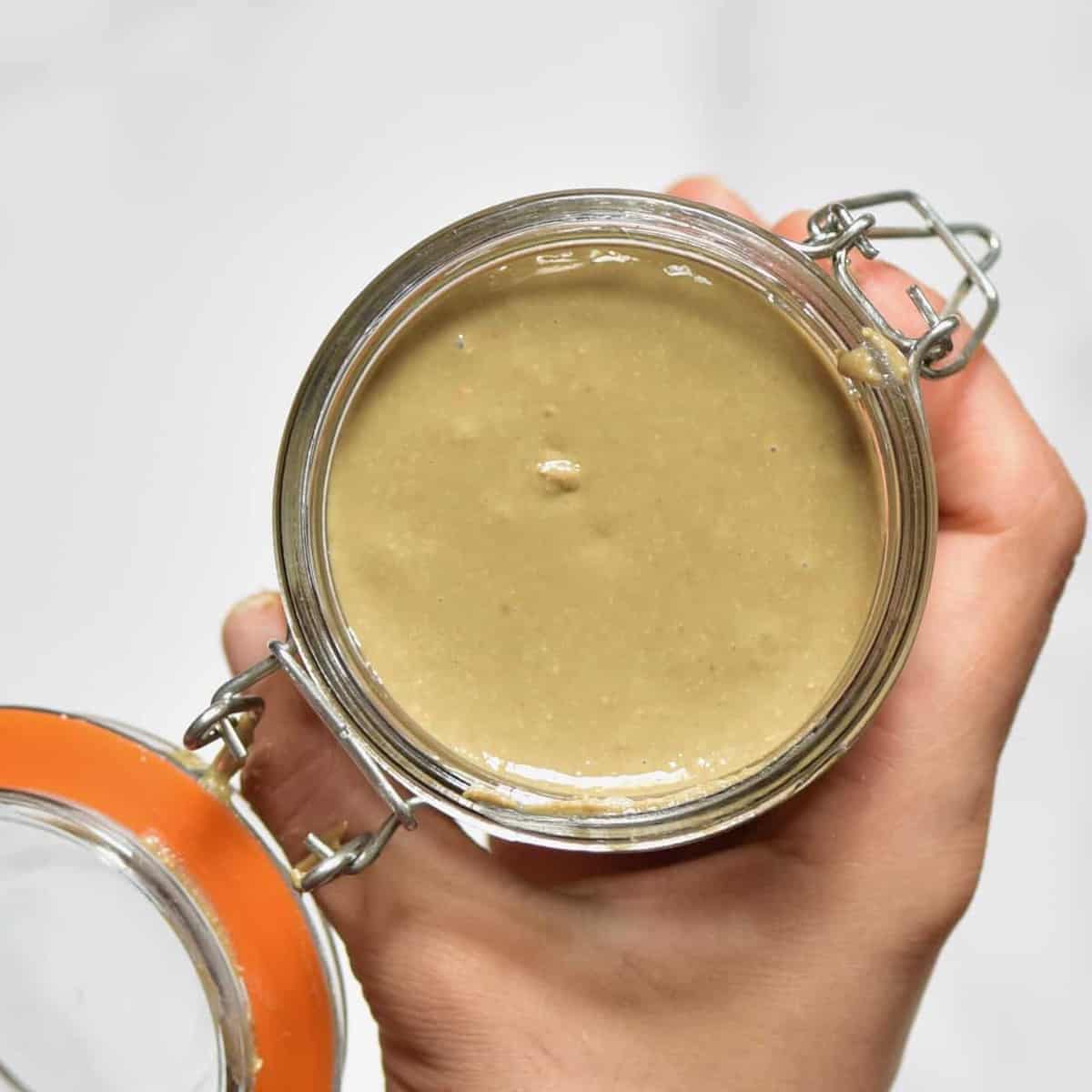
It’s also optional to add in some salt and/or sweetener. Just make sure to remember that any flavored nut or seed butter will impact the shelf life. So always do so in small batches from the main sunflower butter jar.
Once ready, enjoy the seed butter as a spread, dip, alternative to nut butter, and more! Keep reading for all my top recommendations. Honestly, it’s an ingredient that I return to time and time again. So much so that I now buy sunflower seeds in bulk (and store them in the freezer)!
And if you’re interested in making more simple “butters”, you might also like this recipe for hemp seed butter, or even granola butter (oatmeal butter)
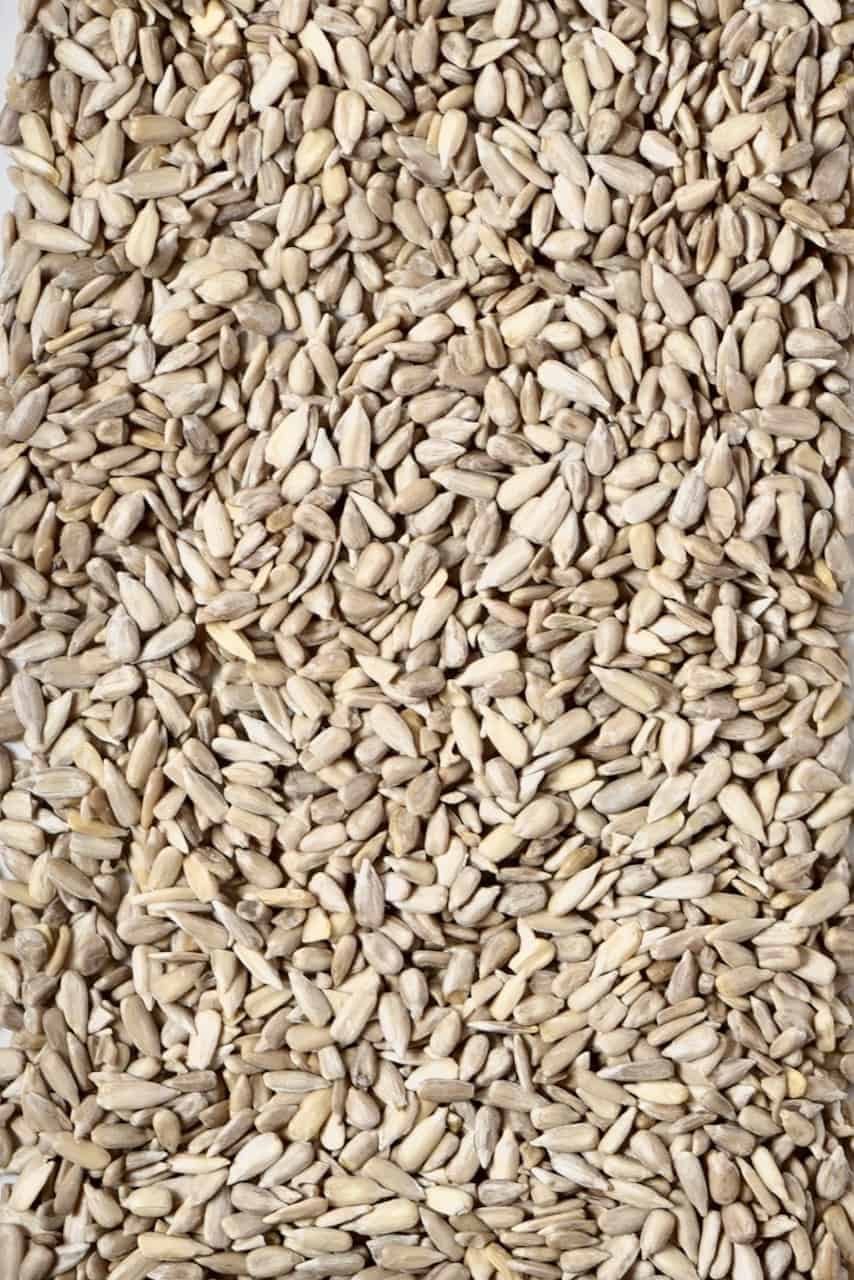
How to make homemade sunflower seed butter
As with all nut and seed butter recipes, the process for making this delicious homemade sunflower is ridiculously simple. Keeping reading for the roasted seed method followed by the sprouted method.
Step 1: Roast the sunflower seeds
This step helps the seeds to start releasing some of their natural oils, as well as enhances the flavor. However, if you’d prefer to make raw sunbutter then you can skip this step.
To begin, spread the raw sunflower seeds across a baking sheet. Then, roast the raw sunflower seeds in the oven at 330ºF/165ºC (fan assisted) for 8 minutes, or until the seeds are golden brown.
Then, remove the sunflower seeds from the oven and leave them to one side until cool to touch.
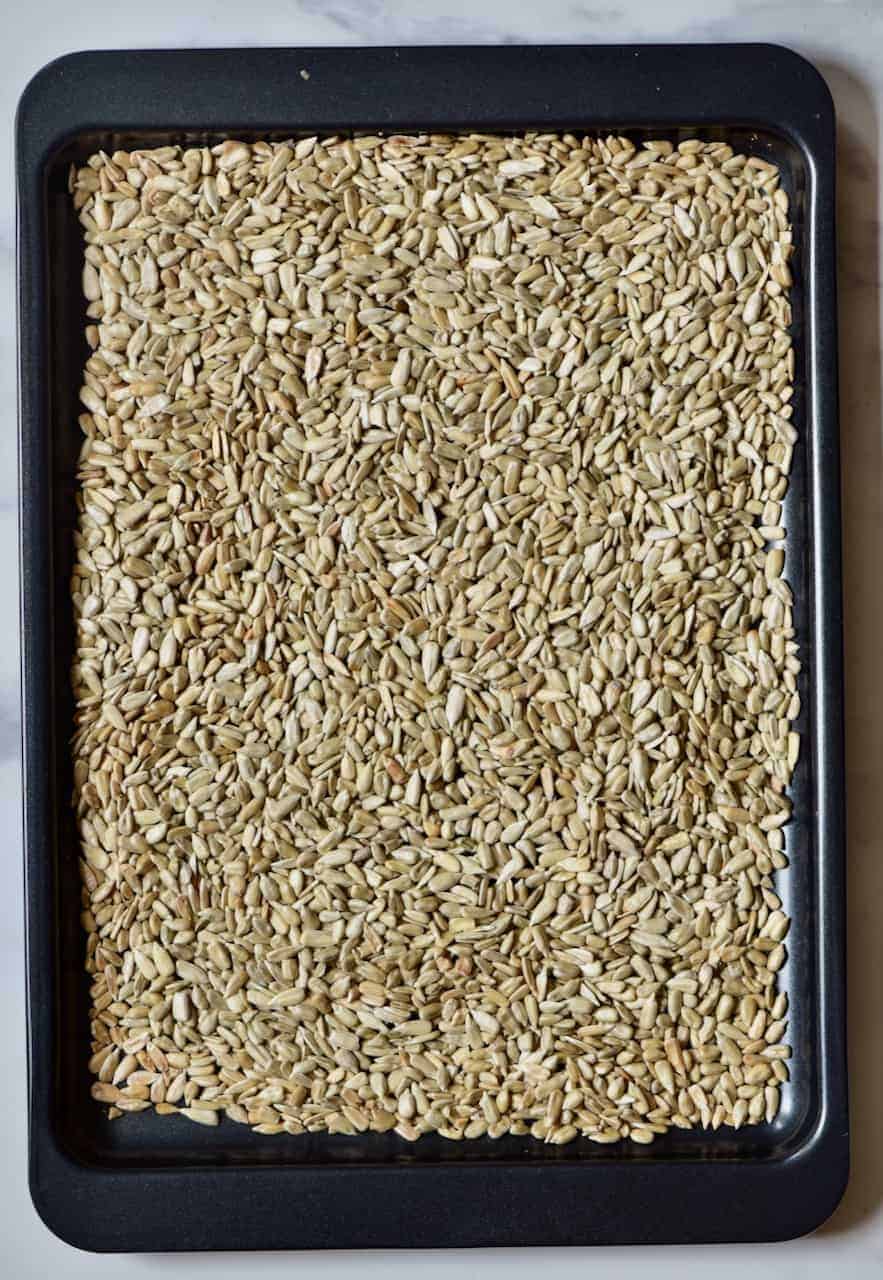
Step 2: Blend the seeds into a smooth butter
Pour the sunflower seeds into your food processor or blender and blend till smooth. During this process, the seeds will go through several stages. First, they’ll be ground into a fine meal. Then they will start to thicken up and form a ball, then a thick paste, and finally a smooth creamy sunflower butter.
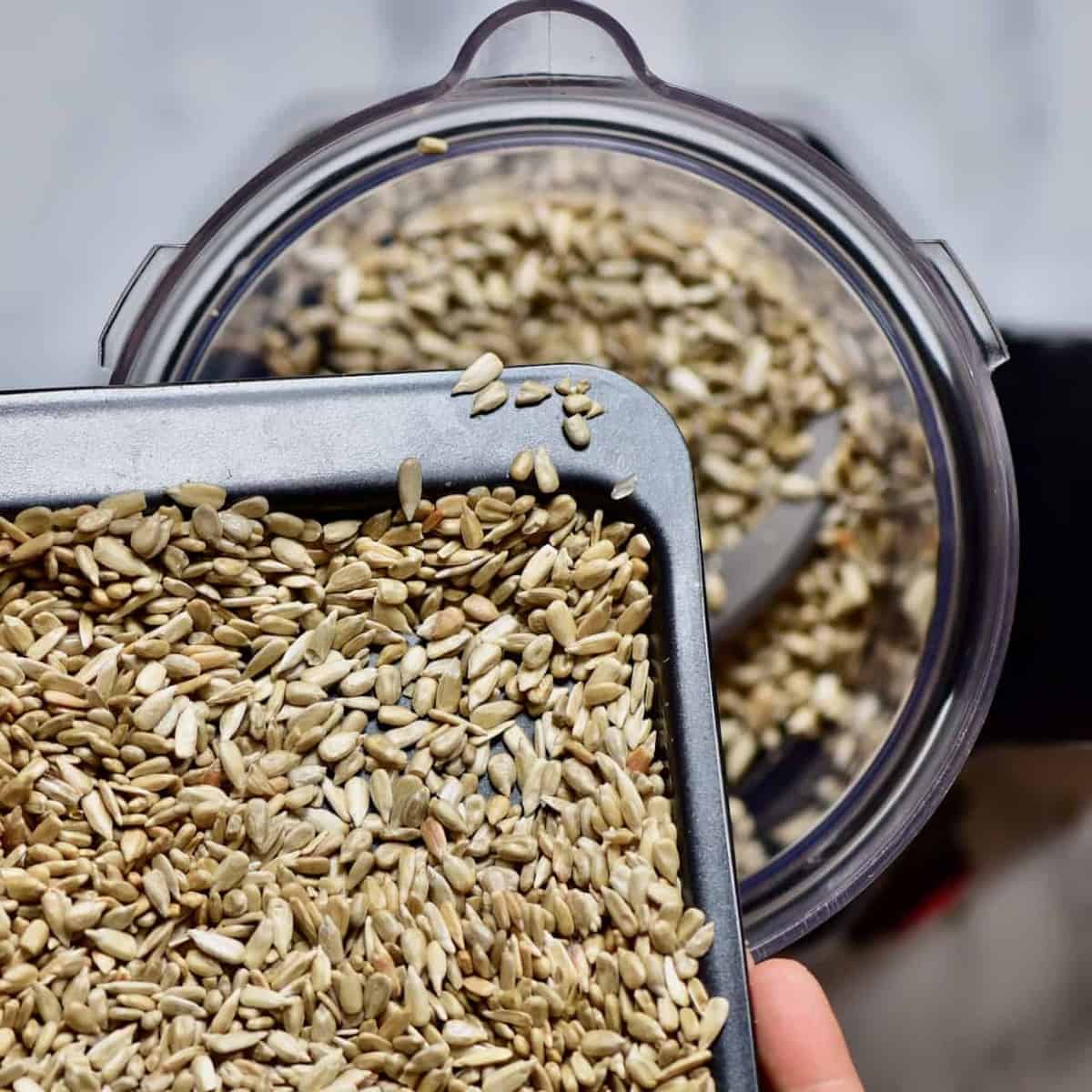
Do this in intervals of around 2-3 minutes, so the seeds ( and machine) don’t overheat. The longer you blend, the runnier consistency the homemade sunflower seed butter will be.
If you don’t have a processor/blender that auto scrapes down the sides, you should do that every time you pause the machine, to make sure all the seeds are blended till super smooth.
This process can take as little as 2 minutes, 15 minutes, or even 30+ depending on your machine (for me, it takes 12-15 minutes for the super smooth sunflower butter I end up with).
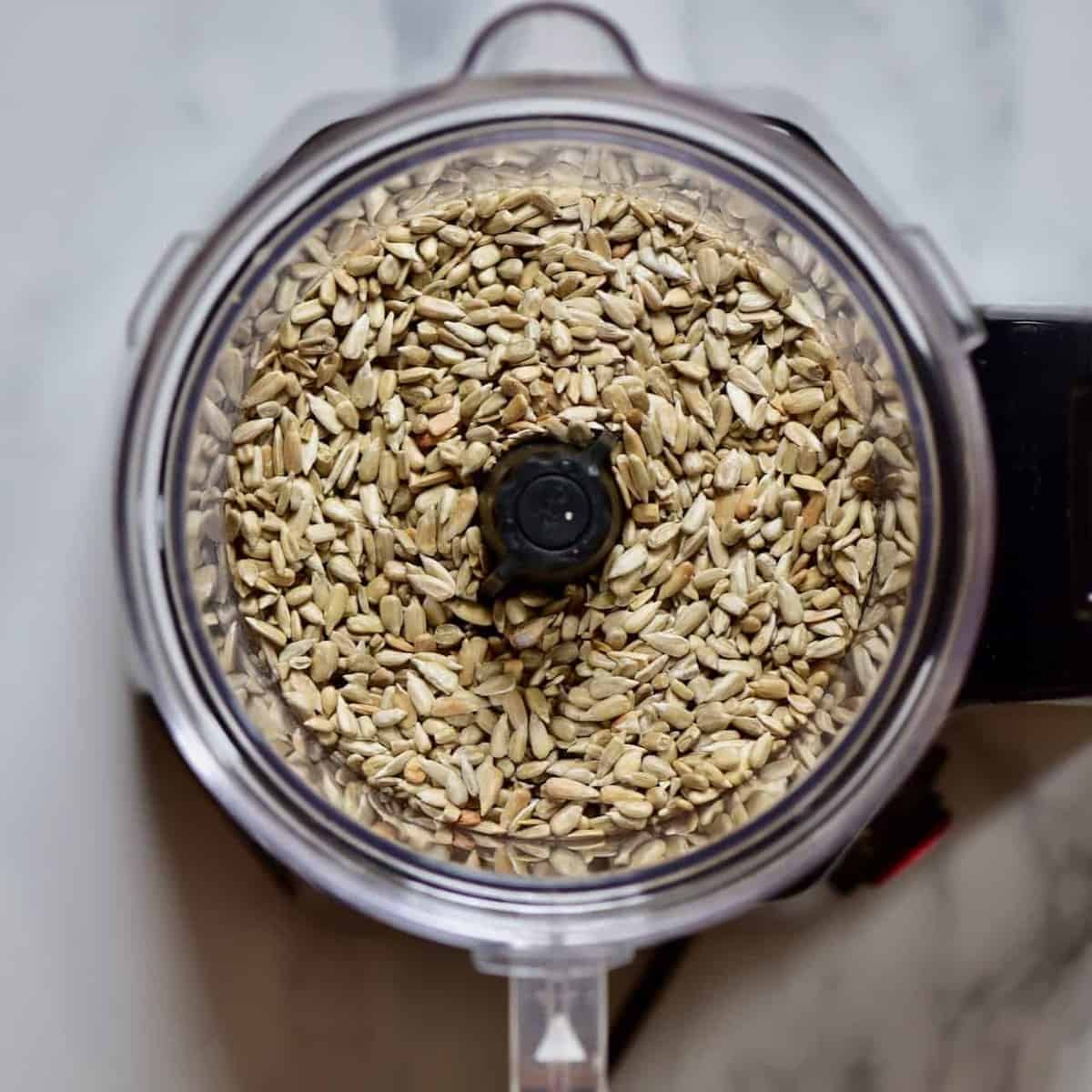
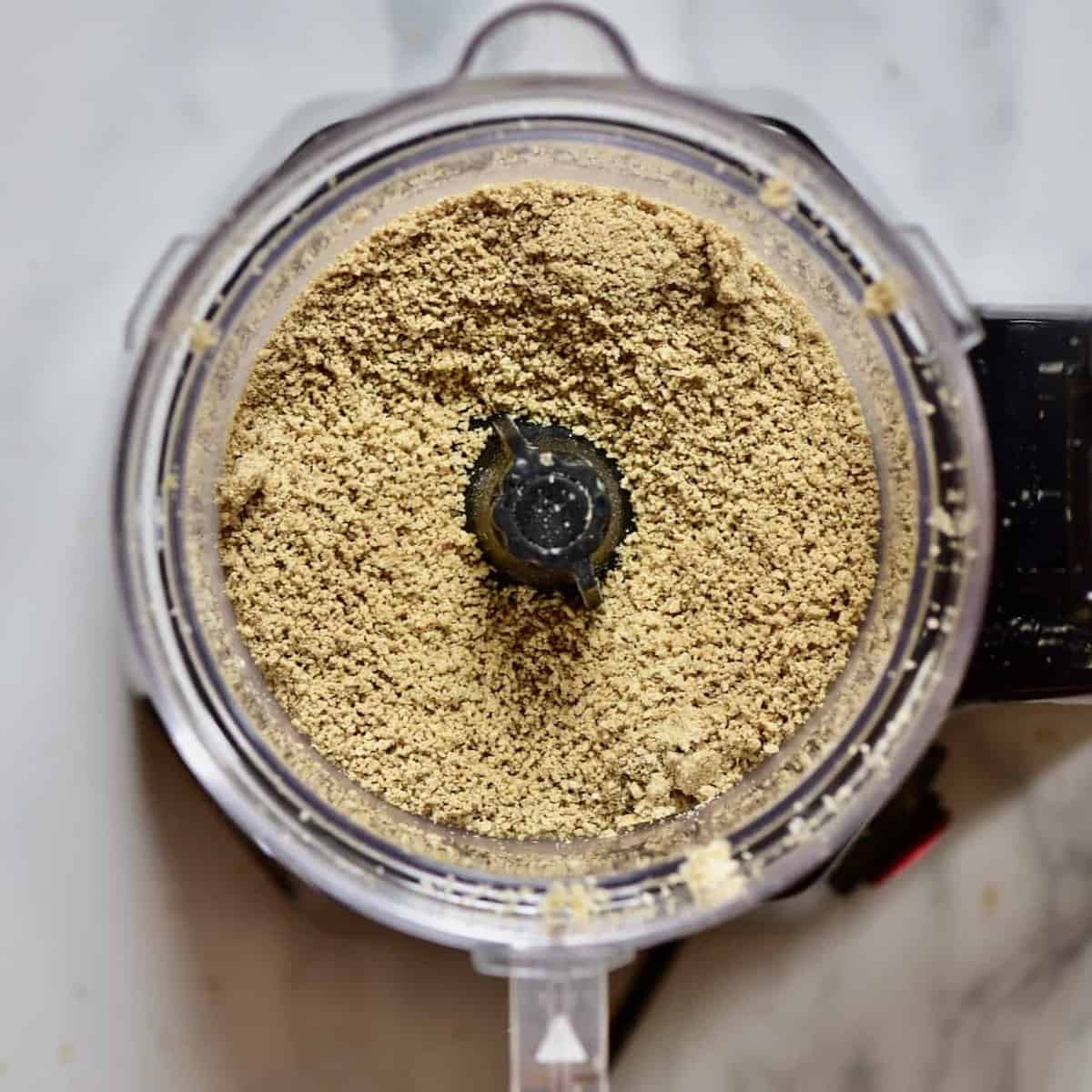
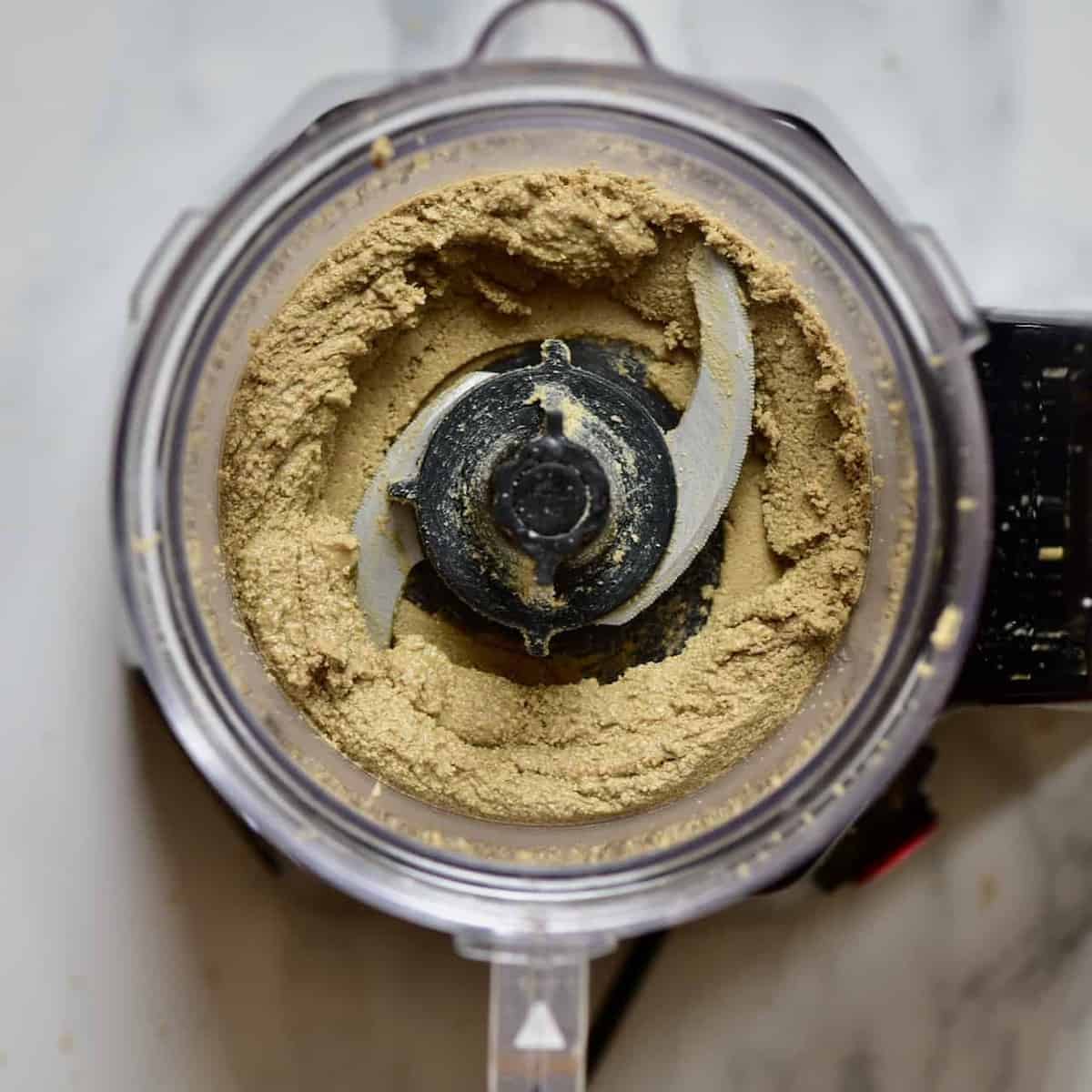
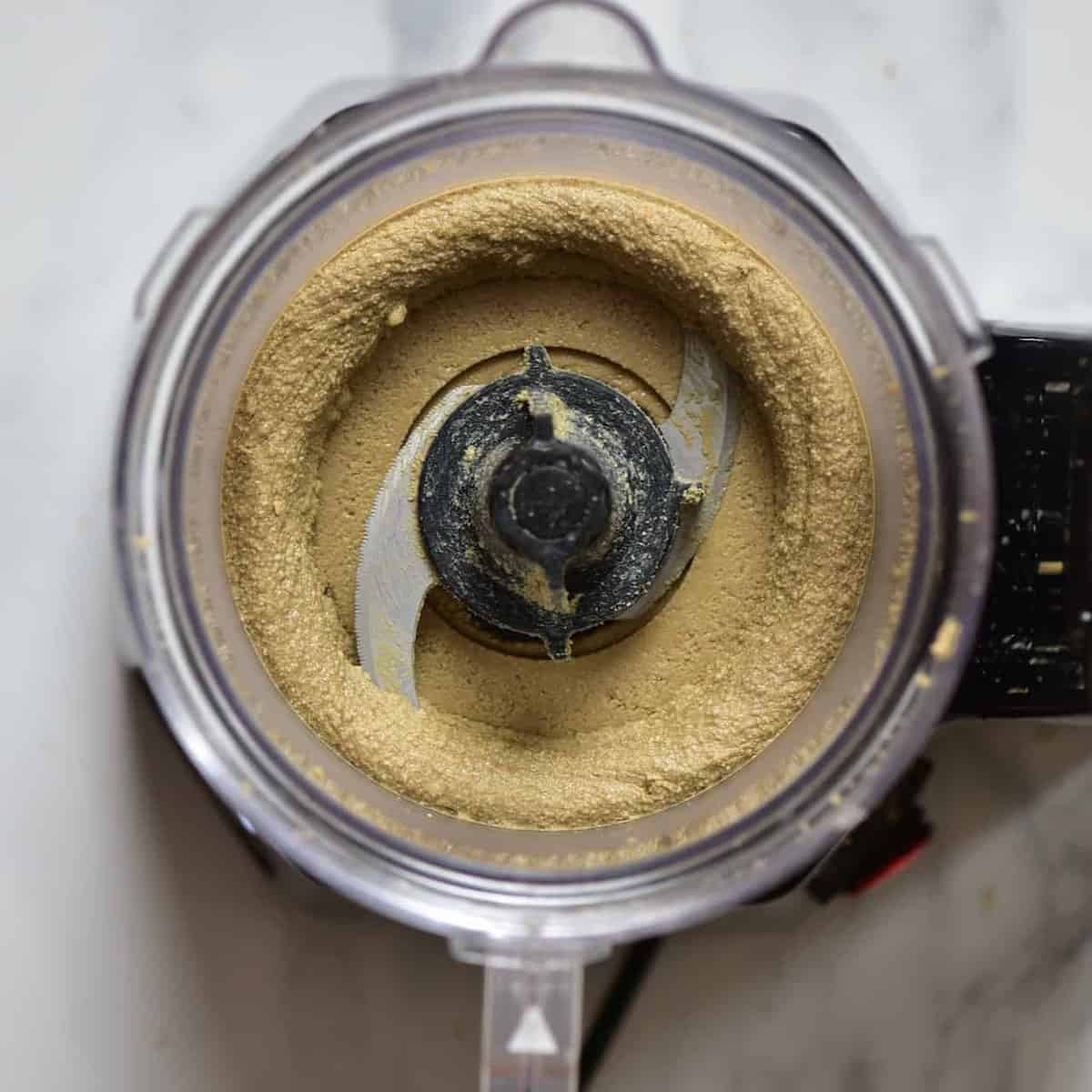
I suggest using a high-speed blender/processor if possible. Otherwise, the process can take quite a bit longer than it took me. However, if you do have a relatively mid-level powered food processor/blender, don’t fret! Give the seeds some extra time to blend, giving the machine a break every couple of minutes.
If you’re using raw sunflower seeds, you might find that they won’t move past the powdery/ball stage. At that point, you may need to add a tablespoon of neutral oil to get the machine working. However, I recommend allowing it to run for 10 minutes (with breaks every 2-3 minutes) first, to give it a chance, first!
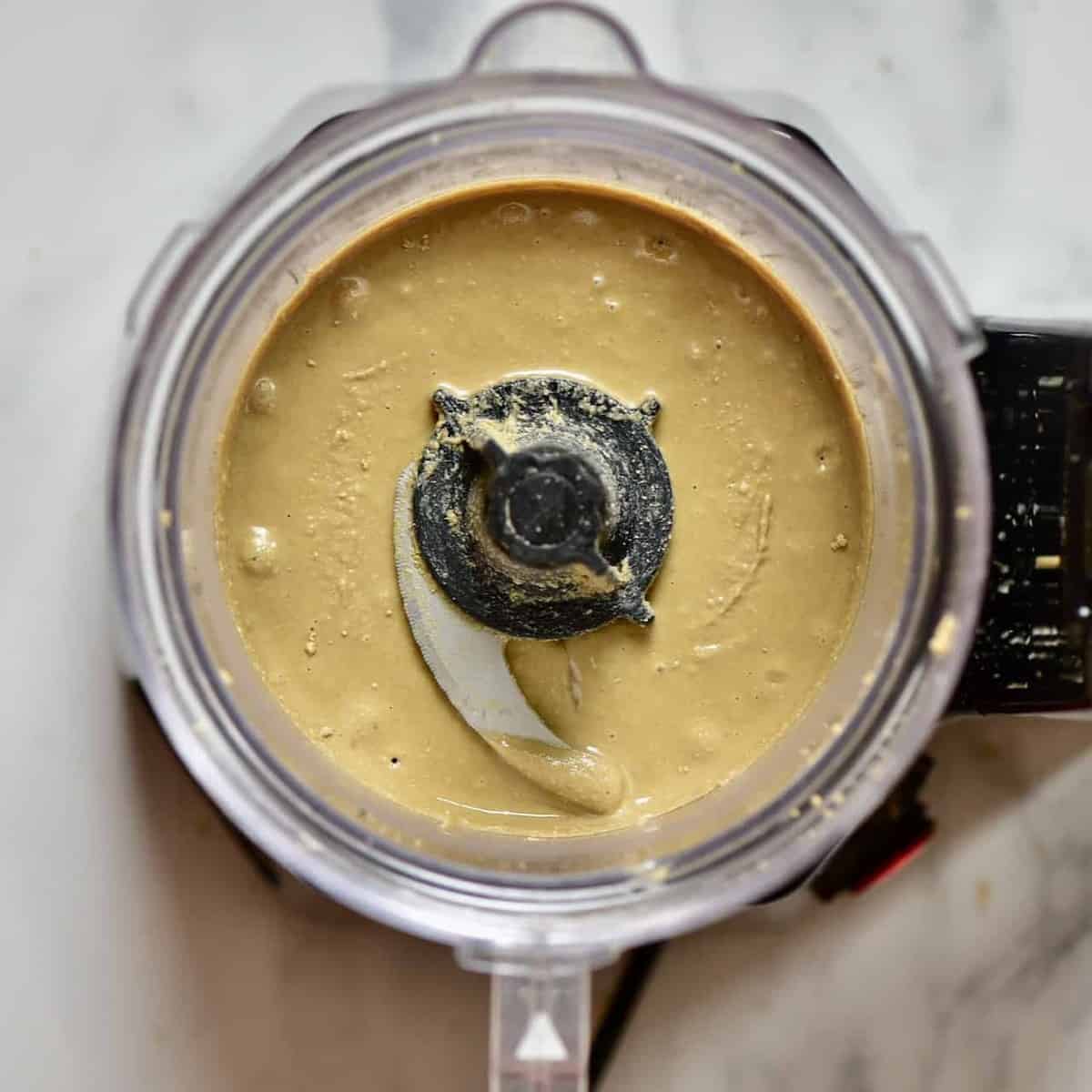
Once the homemade sunflower seed butter is ready, transfer it to an airtight glass container.
If you want to add any extra ingredients – like salt, sweetener, flavorings, etc (keep reading below for ideas). Add them in right at the end (after achieving your desired consistency) – then pulse a few times to distribute it within the sunflower butter.
Can I use soaked seeds (sprouted) for sunflower butter?
Yes, but the process will take quite a bit longer. You’ll first need to soak the seeds in filter water for 3 hours (or overnight). Then, drain the seeds and pat them dry (well!).
You can then use a dehydrator at 104ºF/40ºC for 10-12 hours, or until the seeds are completely dry (if you want to make raw sunflower butter). Alternatively, roast them in the oven at a low temperature (until dry) – then increase the heat to roast them if preferred.
Why go to this effort? Soaking the seeds can help to “activate” them. This means the nutrients within will become more bioavailable for the body (meaning more easily absorbed). Also, the phytic acid (which is an enzyme inhibitor) will be reduced.
How to store
Store: You can store the sunflower butter in the refrigerator for up to 6 weeks. Make sure to use clean utensils every time you use some.
Freeze: Alternatively, transfer the sunbutter to a freezer-safe container and freeze for between 3-4 months.
Note: When you put any nut or seed butter in the fridge then it will solidify and the oils can separate. Don’t panic – simply mix it well before using. You can also move your portion to a small bowl and allow it to rest at room temperature for 10 minutes before stirring and using.
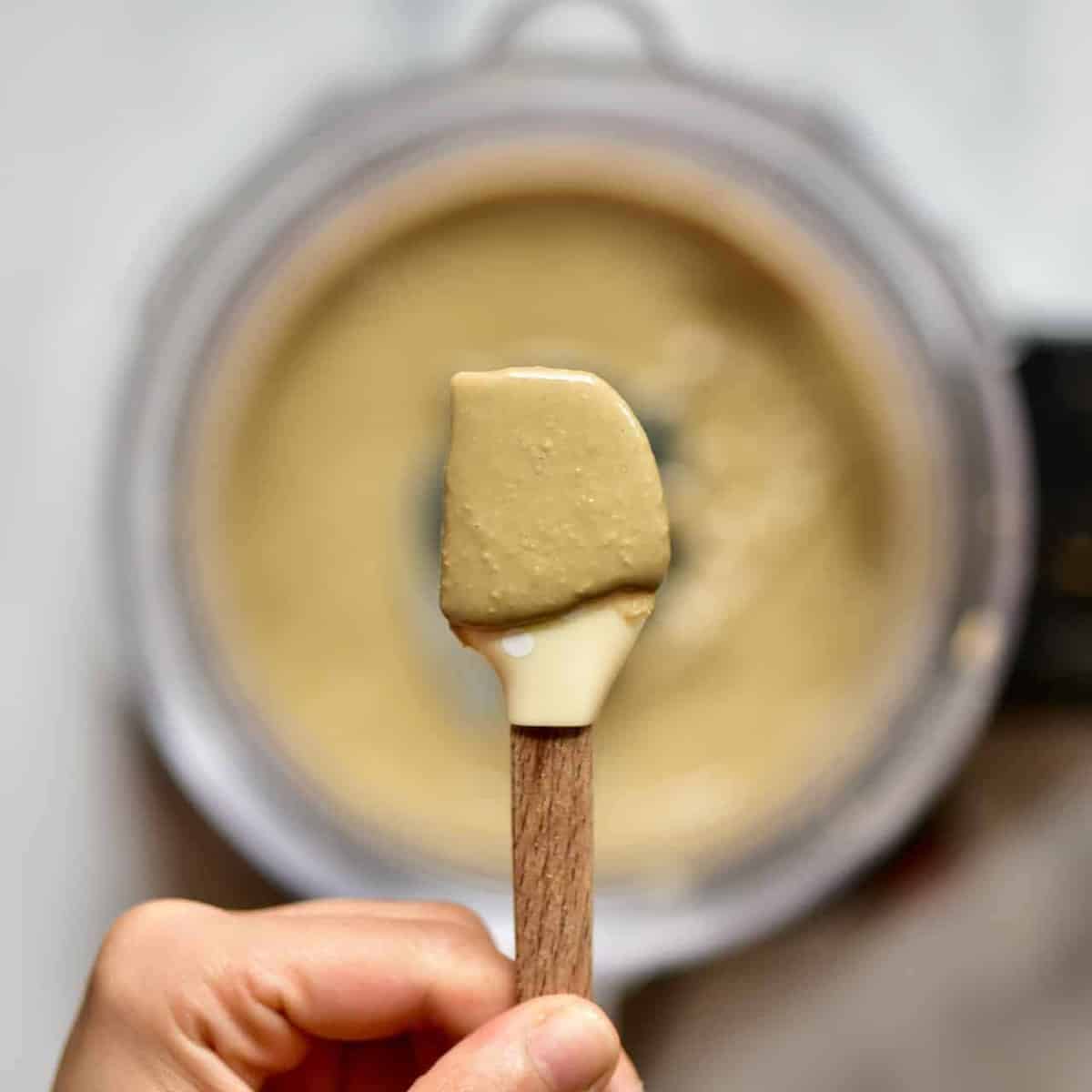
Flavored sunflower seed butter recipe variations
- Homemade Vanilla extract or Vanilla Powder can be added to the butter.
- Add a pinch of sea salt – to enhance the flavors of the sunflower seeds and no impact on shelf life.
- I also think Cinnamon works well in pretty much every nut and seed butter. Yum!
- Sweetener: You can use dates, granulated sugar (like unrefined coconut sugar), sweetener (like monk fruit or erythritol), or even maple syrup/honey (read notes for method with liquid sweetner).
- Shredded coconut – will add texture and a delicate layer of flavor.
- Chocolate sunflower butter: I recommend adding between 2-4 tbsp of cocoa powder with the sweetener of your choice (adjusted, to taste) and a pinch of salt. To enhance the flavor of the chocolate, you could also add a tsp of instant coffee powder. Vanilla is optional, too. If it becomes too thick, you may need a tablespoon of melted coconut oil.
- Maple cinnamon sunflower seed butter: I recommend starting with 1-2 tbsp maple syrup, 1 tsp cinnamon, and ½ tsp vanilla extract (optional) to begin with- then increase to taste. A pinch of salt will further enhance all the above flavors. To do so, roast the seeds covered with the maple then grind. Once you’ve reached the correct consistency, then you can add the cinnamon/vanilla (if using). If you add the maple into the machine, the seed butter may seize and thicken.
Note that any time you add extra ingredients to your sunflower butter, then you’ll impact the shelf life. In general, I aim to use flavored versions within 2 weeks. It’s also best (apart from liquid sweeteners) to add in any extra ingredients at the END of the process – when your sunflower butter has already achieved the correct consistency!
How to use sunflower seed butter
I can not overstate how useful having a jar of sunflower seed butter in the kitchen at all times is. Not only can you use sunbutter as an alternative to peanut butter, almond butter, and other nut butters (in fact it’s my favorite all-purpose substitute in recipes for those with a nut allergy).
In terms of savory dishes, you can use sunbutter within savory sauces, as part of drizzles and salad dressings, and even as an ingredient within dipping sauces. Sunbutter can also be used in the best hummus recipe to replace homemade tahini.
For some sweet inspiration… well, this list will take a bit longer to write. Homemade sunflower seed butter works well in raw treats including cookies, protein balls/bars, cakes and quick breads, pancakes, and more. You can also use it within ice-cream recipes, waffles, muffins, biscuits (and stuffed cookies!), naturally sweetened banana bread, etc. Sun butter can also be used in homemade granola recipes too. I also like to add mine to homemade smoothies for extra nutrients!
In terms of simple nut/see butter swap-out uses – this sunbutter can be used as a simple spread on toast, homemade New York style bagels, in a sandwich, or over fruit, stirred into or drizzled over breakfast oatmeal, yogurt (dairy yogurt or dairy-free homemade coconut yogurt, homemade almond yogurt, or soy yogurt), and hot cocoa! It can also be used for a fun alternative butter in these homemade Vegan peanut butter cups.
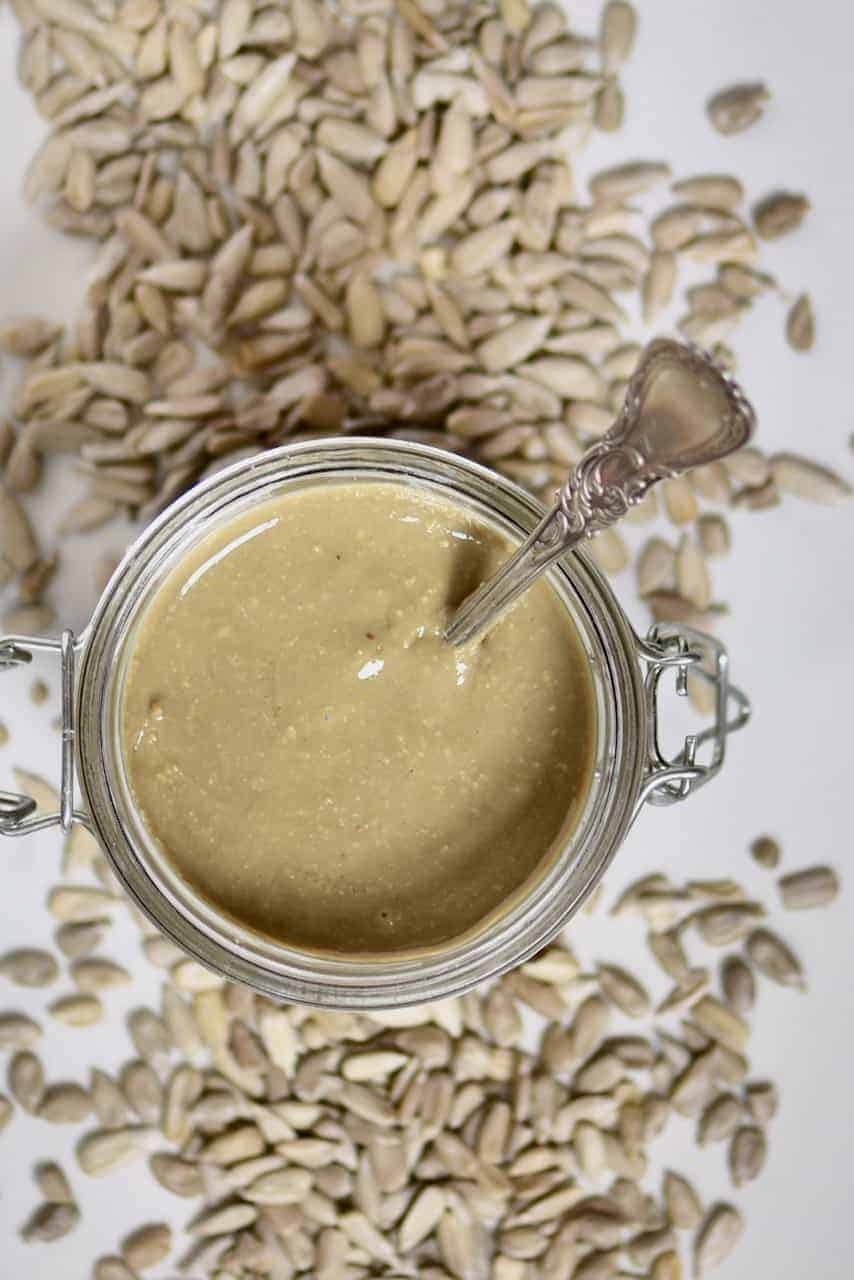
FAQs
When making homemade sunflower better, yes it needs to be refrigerated. This is because there are no preservatives or additives in the recipe that make it shelf-stable.
While they aren’t toxic for your dog, because of their high fat levels, it’s best to keep serving sizes low (around 1 Tbsp) to avoid gastro-upset!
Sunflower seeds are, so yes, this one-ingredient sunflower butter should be fine. However, I recommend sticking to a serving of between 30-50g of sunflower seeds (around 3-4 tablespoons of sunbutter).
Although I’ve never tried, I think it’s possible to prepare nut and seed butters in a spice grinder (in smaller batches). I recommend letting it run in 15-second intervals until it reaches your desired consistency (this may take several minutes or as little as a minute).
Another option is to use mortar and pestle (especially the Japanese Suribachi) but be warned that it requires some arm strength!
Let me know in the comments if you give one of these methods a try!
Yes, but they will be harder to process (as if you’re using raw seeds). I find they’re easier to process when still warm and newly roasted.
Top tips
- Don’t reduce the amount of seeds used: It might seem like a lot if you’re trying this sunbutter recipe for the first time. However, your machine with struggle to work and blend properly if you don’t add enough seeds. I like to use 2 cups of seeds for blenders and 3 cups for food processors (though I can never get results quite as smooth with a food processor).
- Patience is key: Depending on your particular food processor/blender, this process can take as little as 1-2 minutes, up to 20 (or more!). Just remember to give your machine breaks so it doesn’t overheat, and scrape down the sides.
- If your blender/food processor is struggling: If your machine is struggling to move past the “thick paste” stage for several minutes, then it my be time to add in one tablespoon of oil (I recommend extra virgin coconut oil). This usually isn’t necessary though, when using roasted seeds.
- For raw sunflower seed butter: You’ll likely need to add a little additional oil, unfortunately. Roasting really helps the oils to release in the seeds. Without that step, these seeds will either take a LOT longer to process or simply won’t move past a certain stage unless a little oil is added to help move the process along. I’ve also found that raw sunflower butter is usually slightly more bitter in flavor, too.
- If you need to use oil: Make sure to use a neutral oil like coconut oil, mild olive oil, grapeseed oil, avocado oil, etc.
Other nut and seed butter recipes
- Simple Homemade Walnut Butter Recipe
- How to Make Homemade Cashew Butter
- Homemade Pistachio Butter
- DIY Homemade Vegan Nutella Recipe
- How to make Homemade Hazelnut Butter
- How to make Homemade Brazil Nut Butter
- Coffee Peanut Butter Spread (Espresso Spread)
As always, if you try this sunflower seed butter recipe, let me know your thoughts and questions in the comments below. Also, feel free to tag me in your recreations @AlphaFoodie.
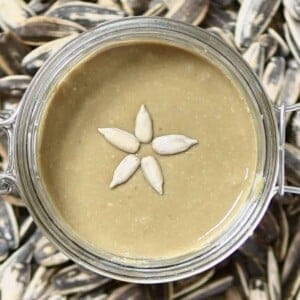
Homemade Sunflower Seed Butter (Oil-Free)
Equipment
Instructions
Step 1: Roast the sunflower seeds
- This step helps the seeds start releasing some of their natural oils and enhances the flavor. However, if you'd prefer to make raw sunbutter, then you can skip this step.Spread the raw sunflower seeds across a baking sheet. Then, roast the seeds in the oven at 330ºF/165ºC (fan assisted) for 8 minutes, or until the seeds are golden brown.
- Remove the sunflower seeds from the oven and leave them to one side until cool to touch.
Step 2: Blend the seeds into a smooth butter
- Pour the sunflower seeds into your food processor or blender and blend till smooth. During this process, the seeds will go through several stages. First, they'll be ground into a fine meal. Then they will start to thicken up and form a ball, then a thick paste, and finally a smooth, creamy sunflower butter.Do this in intervals of around 2-3 minutes, so the seeds (and your machine) don't overheat. The longer you blend, the runnier consistency the seed butter will be.If you don't have a processor/blender that auto scrapes down the sides, you should do that every time you pause the machine to make sure all the seeds are blended till super smooth.This process can take as little as 2 minutes, 15 minutes, or even 30+ depending on your machine (for me, it takes 12-15 minutes for the super smooth sunflower butter I end up with).If you're using raw sunflower seeds, you might find that they won't move past the powdery/ball stage. At that point, you may need to add a tablespoon of neutral oil to get the machine working. However, I recommend allowing it to run for 10 minutes (with breaks every 2-3 minutes), to give it a chance, first!
- Once the homemade sunflower seed butter is ready, transfer it to an airtight glass container.If you want to add extra ingredients – like salt, sweetener, flavorings, etc. (keep reading below for ideas), add them in right at the end (after achieving your desired consistency) – then pulse a few times to distribute it within the sunflower butter.
Can I use soaked seeds (sprouted) for sunflower butter?
- Yes, but the process will take quite a bit longer. You’ll first need to soak the seeds in filter water for 3 hours (or overnight). Then, drain the seeds and pat them dry (well!).
- You can then use a dehydrator at 104ºF/40ºC for 10-12 hours or until the seeds are completely dry (if you want to make raw sunflower butter). Alternatively, roast them in the oven at a low temperature (until dry) – then increase the heat to roast them if preferred.Why go to this effort? Soaking the seeds can help to "activate" them – which means the nutrients within will become more bioavailable for the body (meaning more easily absorbed), and the phytic acid reduces (which is an enzyme inhibitor).
How to Store
- Store: you can store the sunflower butter in the refrigerator for at least 6 weeks. Make sure to use clean utensils every time you use some.Freeze: alternatively, transfer the sunbutter to a freezer-safe container and freeze for between 3-4 months.Note* When you put any nut or seed butter in the fridge, it will solidify, and the oils can separate. Don't panic – simply mix it well before using. You can also move your portion to a small bowl and allow it to rest at room temperature for 10 minutes before stirring and using.
Video
Notes
- Don’t reduce the amount of seeds used: it might seem like a lot if you’re trying this sunbutter recipe for the first time. However, your machine will struggle to work and blend properly if you don’t add enough seeds. I like to use 2 cups of seeds for blenders and 3 cups for food processors (though I can never get results quite as smooth with a food processor).
- Patience is key: depending on your particular food processor/blender, this process can take as little as 1-2 minutes, up to 20 (or more!). Just remember to give your machine breaks so it doesn’t overheat, and scrape down the sides.
- If your blender/food processor is struggling: if your machine is struggling to move past the “thick paste” stage for several minutes, then it may be time to add in one tablespoon of oil (I recommend extra virgin coconut oil). This usually isn’t necessary though, when using roasted seeds for sunbutter.
- For raw sunflower seed butter: you’ll likely need to add a little additional oil, unfortunately. Roasting really helps the oils to release in the seeds and without that step, these seeds will either take a LOT longer to process or simply won’t move past a certain stage unless a little oil is added to help move the process along. I’ve also found that raw sunflower butter is usually slightly more bitter in flavor, too.
- If you need to use oil: Make sure to use neutral oil like coconut oil, mild olive oil, grapeseed oil, avocado oil, etc.
- Homemade Vanilla extract or Vanilla Powder can be added to the butter.
- Add a pinch of sea salt – to enhance the flavors of the sunflower seeds and with no impact on shelf life.
- I also think Cinnamon works well in pretty much every nut and seed butter. Yum!
- Sweetener: you can use dates, granulated sugar (like unrefined coconut sugar), sweetener (like monk fruit or erythritol), or even maple syrup/honey (read the notes for a method with liquid sweetener).
- Shredded coconut – will add texture and a delicate layer of flavor.
- Chocolate sunflower butter: I recommend adding between 2-4 Tbsp of cocoa powder with the sweetener of your choice (adjusted, to taste) and a pinch of salt. To enhance the flavor of the chocolate, you could also add a tsp of instant coffee powder. Vanilla is optional, too. If it becomes too thick, you may need a tablespoon of melted coconut oil.
- Maple cinnamon sunflower seed butter: I recommend starting with 1-2 tbsp maple syrup, 1 tsp cinnamon, and ½ tsp vanilla extract (optional) to begin with- then increase to taste. A pinch of salt will further enhance all the above flavors. To do so, roast the seeds covered with the maple then grind. Once you’ve reached the correct consistency, then you can add the cinnamon/vanilla (if using). If you add the maple into the machine, the seed butter may seize and thicken.
Nutrition
Nutrition information is automatically calculated, so should only be used as an approximation.

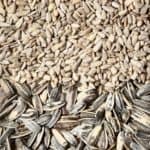









Perfect
My daughter has several food allergies so I need sunflower seeds butter for some recipes. I decided to learn how to do it because of an « emergency », I’m never buying already made sunflower seeds butter ever ! This one is amazing !
Thank you so much for your comment, Helene. Homemade is the best, right 🙂